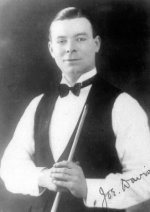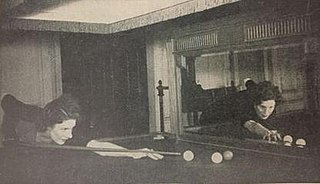Related Research Articles

Joseph Davis was an English professional snooker and English billiards player. He was the dominant figure in snooker from the 1920s to the 1950s, and has been credited with inventing aspects of the way the game is now played, such as break-building. With the help of equipment manufacturer Bill Camkin, he drove the creation of the World Snooker Championship by persuading the Billiards Association and Control Council to recognise an official professional snooker championship in 1927. Davis won the first 15 world championships from 1927 to 1946, and he is the only undefeated player in World Snooker Championship history. In 1935, he scored the championship's first century break.

Walter Weir Wilson Donaldson was a Scottish professional snooker and billiards player. He contested eight consecutive world championship finals against Fred Davis from 1947 to 1954, and won the title in 1947 and 1950. Donaldson was known for his long potting and his consistency when playing, and had an aversion to the use of side. In 2012, he was inducted posthumously into the World Professional Billiards and Snooker Association's World Snooker Hall of Fame.
The 1927 World Snooker Championship was a snooker tournament held at several venues from 29 November 1926 to 12 May 1927. At the time, it was titled the Professional Championship of Snooker but it is now recognised as the inaugural edition of the World Snooker Championship. The impetus for the championship came from professional English billiards player Joe Davis and billiard hall manager Bill Camkin, who had both observed the growing popularity of snooker, and proposed the event to the Billiards Association and Control Council. Ten players entered the competition, including most of the leading English billiards players. The two matches in the preliminary round were held at Thurston's Hall in London, and the semi-finals and final took place at Camkin's Hall in Birmingham. The players involved determined the venues for the quarter-finals, resulting in matches in London, Birmingham, Nottingham and Liverpool.
The 1928 World Snooker Championship was a professional snooker tournament held at various venues from 28 December 1927 to 17 May 1928. It was the second staging of the World Snooker Championship. It was played on a challenge basis with the other six entrants playing off for the right to challenge defending champion Joe Davis in the final. The final was held at the Camkin's Hall in Birmingham, England, with three of the other matches contested there, and one each played in Leamington Spa and Nottingham.
The 1929 World Snooker Championship, known at the time as the Professional Championship of Snooker, was a snooker tournament held between 17 December 1928 and 7 March 1929 at various venues in England, with the final taking place from 4 to 7 March 1929 at the Lounge Hall, Nottingham. Defending champion Joe Davis won the title for the third time by defeating Tom Dennis by 19 frames to 14 in the final, after securing a winning margin at 17–12.
The English Amateur Championship, an annual snooker competition, is the highest-ranking and most prestigious amateur event in England. It is also the oldest and longest-running snooker tournament in the world, having been established in 1916, three years before the standard rules of the game were first established in 1919 by the Billiards Association and Control Club was formed, and 11 years before the World Snooker Championship.
The 1931 World Snooker Championship was a snooker tournament held at the Lounge Hall in Nottingham, England from 27 April to 1 May 1931. Despite increasing interest in the game of snooker, only two players entered the competition for the title: defending champion Joe Davis and three-times runner-up Tom Dennis. It was the fifth time that the World Snooker Championship had been contested since its inception in 1927. Davis won his fifth World title by defeating Dennis 25–21. Dennis led 19–16 at one stage but Davis won 9 of the next 11 frames to take the title. The highest break of the match was 72, compiled by Davis in the 41st frame.
The 1932 World Snooker Championship, known at the time as the Professional Championship of Snooker, was a professional snooker tournament that took place from 14 to 20 April 1932, with the final being held at Thurston's Hall in London, England. It is recognised as the sixth edition of the World Snooker Championship. The defending champion, Joe Davis from England, won the title for the sixth time by defeating New Zealander Clark McConachy by 30 frames to 19 in the final. The score when Davis achieved a winning margin was 25–18, with dead frames played afterwards. Davis set a new Championship record break of 99 in the 36th frame of the final. McConachy had become the first player from outside the British Isles to enter the championship. The only other participant was Tom Dennis, who was defeated 11–13 by McConachy in the semi-final at Skegness.
The 1933 World Snooker Championship, known at the time as the Professional Championship of Snooker, was a snooker tournament held between 23 March and 16 June at various venues in England, with the final beginning on 12 June 1933 at Joe Davis's Saloon in Chesterfield, England. It was the seventh edition of the championship, and Joe Davis won his seventh title by defeating Willie Smith by 25 frames to 18 in the final. The highest break of the tournament was 72, compiled by Davis in the fortieth frame of the final.
The 1934 World Snooker Championship, known at the time as the Professional Championship of Snooker, was a snooker tournament held partly at the Lounge Hall in Nottingham and then at the Central Hall in Kettering, from 2 to 6 April 1934. Joe Davis won the title for the eighth time by defeating Tom Newman, the only other entrant, by 25 frames to 22. At one stage Newman led 14–13, but Davis then pulled ahead to lead 24–18 and, although Newman won the next four frames, Davis took the 47th frame to secure the title. Davis compiled a break of 70 in the third frame.
The 1935 World Snooker Championship was a snooker tournament held at Thurston's Hall in London, England from 8 to 27 April 1935. It was the first edition of the Championship to incorporate "world" in its name, being called the World's Professional Snooker Championship. Joe Davis won the title for the ninth time by defeating Willie Smith by 28 frames to 21 in the final, having achieved a winning margin at 25–20. Davis recorded the first century break in the history of the championship, a 110 in his semi-final match against Tom Newman.
The 1936 World Snooker Championship was a snooker tournament that was held at the Burroughes and Thurston's Halls in London, England from 23 March to 2 May 1936. There were 13 entries; a significant increase from five in the previous year and just two in 1934. Defending champion Joe Davis won the Championship for the tenth consecutive time, defeating Horace Lindrum in the final 34–27. Horace Lindrum became the first Australian to compete at the World Championship and made the only century break of the tournament, a 101 in his semi-final match against Stanley Newman.
The 1937 World Snooker Championship was a snooker tournament held at Thurston's Hall in London, England from 22 February to 20 March 1937. It is recognised as the 11th edition of the World Snooker Championship. There were nine participants in the event, with debutants Fred Davis and Bill Withers competing in a qualifying match. Withers won the match to join with the remaining seven players in the main event.
The 1947 World Snooker Championship was a professional snooker tournament that took place from 20 January to 25 October 1947. The final was held at the Leicester Square Hall in London, England, from 13 to 25 October. The semi-finals were completed in March, but the final was delayed due to building works at the venue, which had been bombed in October 1940. Walter Donaldson won the title by defeating Fred Davis by 82 frames to 63 in the final, although he reached the winning margin earlier, at 73–49. Davis made the highest break of the tournament with a 135 clearance in frame 86 of the final.
The 1948 World Snooker Championship was a professional snooker tournament that took place from 9 March to 1 May 1948. It was an edition of the World Snooker Championship first held in 1927. A qualifying event with eight participants was held from 1 to 13 December 1947 at Burroughes Hall and was won by John Pulman, who joined seven other players in the main event.
The 1949 World Snooker Championship was a snooker tournament held at Leicester Square Hall in London, England from 21 February to 7 May 1949, organised by the Billiards and Snooker Control Council. There were 12 entrants, of which eight participated in the main draw. Seven players were placed directly into the main draw. They were joined by Conrad Stanbury, who won the qualifying competition which was held from 10 to 19 February at the same venue. Stanbury won all three of his qualifying matches on the deciding frame.
The 1951 World Snooker Championship was a professional snooker tournament. The final was held at the Tower Circus in Blackpool, England.

Thurston's Hall was a major billiards and snooker venue between 1901 and 1955 in Leicester Square, London. The hall was in the premises of Thurston & Co. Ltd which relocated to Leicester Square in 1901. The building was bombed in 1940 and reopened under a new name, Leicester Square Hall, and new management in 1947. The venue closed in 1955 and the building was demolished to make way for an extension to Fanum House. The Hall was used for many important billiards and snooker matches, including 12 World Snooker Championship finals between 1930 and 1953. It was also the venue of the first World Snooker Championship match in November 1926. The hall was sometimes referred to as "Thurston's Grand Hall". There was also a "Minor Hall" in the same building.

Joyce Gardner (1910–1981) was an English professional English billiards player. She was the Women's Professional Billiards Champion from 1931 to 1933, and from 1935 to 1938.

Eva Collins was an English snooker and billiards player. She was runner-up in the 1930 British Women's Billiards Championship, and in its successor tournament, the Women's Professional Billiards Championship in 1931.
References
- ↑ "Willie Smith in Leamington" . Leamington Spa Courier. 22 May 1925. Retrieved 21 November 2015– via British Newspaper Archive.
- ↑ "The Tudor Billiards hall" . Leamington Spa Courier. 23 September 1932. Retrieved 21 November 2015– via British Newspaper Archive.
- ↑ "Stupendous attraction" . Leamington Spa Courier. 23 December 1927. Retrieved 21 November 2015– via British Newspaper Archive.
- ↑ "Amateur snooker championship" . Leamington Spa Courier. 18 May 1928. Retrieved 21 November 2015– via British Newspaper Archive.